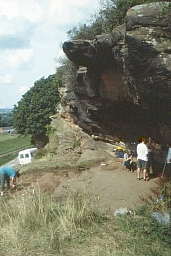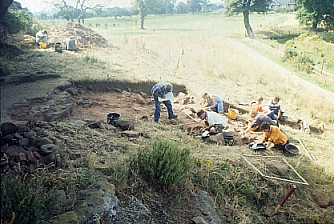The Mesolithic occupation
The main reason we started work on the site in the first place was to investigate the source of the flints that appeared to be eroding from the front edge of a largish talus (the débris mound in front of a cave mouth). This was happening where it had been damaged during the construction of the golf course in 1992. Work began in 1996 and we spent around eleven weeks working on the site over five seasons.
 What we thought to be the talus lay in front of the main rock
shelter and this has formed the focus of most of the excavation
work. The inside of the shelter contained no deposits as later
alterations had removed all of them. Investigation of the cliff
face a few metres farther south suggested that there had also
been a rock shelter here and that it had collapsed at some time
in the distant past. We there sited one trench in front of these
two potential sites. A third trench in 1996 proved virtually
barren, as bedrock lay only a few millimetres below the modern
ground surface.
What we thought to be the talus lay in front of the main rock
shelter and this has formed the focus of most of the excavation
work. The inside of the shelter contained no deposits as later
alterations had removed all of them. Investigation of the cliff
face a few metres farther south suggested that there had also
been a rock shelter here and that it had collapsed at some time
in the distant past. We there sited one trench in front of these
two potential sites. A third trench in 1996 proved virtually
barren, as bedrock lay only a few millimetres below the modern
ground surface.
Almost 10,000 pieces of chert and flint have been recovered from the site, mostly from the trench in front of the cave mouth. They include a few tools and a great deal of waste material. Virtually all the tools conform to the later Mesolithic ‘narrow blade’ tradition, which can be dated c 6800-4300 Cal BC. Analysis began in 1998 and suggested that the type of occupation that took place here was specialised, as most of the tool forms are projectile points. We hope to publish interim reports on the site as we have now amassed large quantities of data.
Trench I
 The first trench, immediately in front of the main shelter,
proved to have in situ Mesolithic archaeology in 1998.
Before this season, all the flint and chert from here has been
residual in later deposits and we now suspect that at least some
of the material came from clearing out the cave in 1744. However,
under the post-medieval archaeology, we found deposits that
contain nothing but prehistoric material. There are patches of
burnt sandstone, which appear to have been hearths and possibly a
very disturbed working floor, away from the cave mouth. So far,
most of the prehistoric deposits belong to the Bronze Age, but
underneath them, we have two or perhaps three Mesolithic deposits
(and, under those, an upper Palaeolithic deposit).
The first trench, immediately in front of the main shelter,
proved to have in situ Mesolithic archaeology in 1998.
Before this season, all the flint and chert from here has been
residual in later deposits and we now suspect that at least some
of the material came from clearing out the cave in 1744. However,
under the post-medieval archaeology, we found deposits that
contain nothing but prehistoric material. There are patches of
burnt sandstone, which appear to have been hearths and possibly a
very disturbed working floor, away from the cave mouth. So far,
most of the prehistoric deposits belong to the Bronze Age, but
underneath them, we have two or perhaps three Mesolithic deposits
(and, under those, an upper Palaeolithic deposit).
Trench II
At first sight in 1996, the second trench seemed to be the most promising of the three. Our suspicions that there had been a rock-shelter here proved correct. The overhang had collapsed, probably during the Mesolithic, and we anticipated that it might have held back the deposits that had formed in the former shelter. However, work in 1997 showed that over the millennia, water dripping off the cliff had thoroughly altered all the deposits, washing material downhill and moving it some distance from where it was dropped.
Trench III
The third trench was disappointing. Here, at the base of what we believed to be the talus, bedrock lay almost directly beneath the turf, which was surprising. It had been assumed that much of the material in front of the shelter consisted of occupation débris from Mesolithic occupation of the site. Because of this, we had not expected the soil to be so shallow here. Survey work in 1997 demonstrated that the apparent débris was in fact a ridge of bedrock.
Test pits
We dug nine test pits in 1997, which showed a similar picture over most of the site: the bedrock had weathered into a crumbly orange sand over which was a pinkish layer containing Mesolithic material. This was then sealed by a topsoil containing mixed prehistoric and post-medieval finds over which the grass was growing.